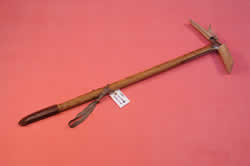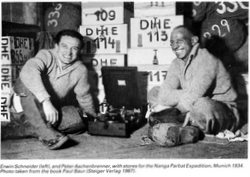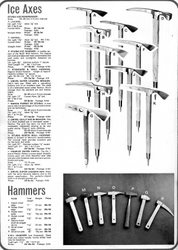
The Scottish Mountain Heritage Collection
Objects Database
Stubai Aschenbrenner (Fuhrerpickel) ice axe
Accession Number
322.2008.1
Object Name
Stubai Aschenbrenner (Fuhrerpickel) ice axe
Created
12/11/2008
Creator
Hermione Cooper
Accession Date
12/11/2008
Brief Description
Stubai Aschenbrenner ice axe. Wooden shaft. Adze, serrated pick. Pointed spike on ferrule with four flat sides. Metal ring with canvas leash which slides up and down shaft. Leather protectors for adze, pick and ferrule.
Materials
wood, metal, canvas, leather
Dimensions
Shaft & ferrule 86(l) x 10(cir)cms. Head 32(l) cms. Adze 7 (w)cms.
Number Of Objects
1
Inscription Description
A diamond with "STUBAI" inside. Underneath
"MADE IN AUSTRIA" Beside that "ASCHENBRENNER FUHRERPICKEL GES.GESCH."
Colour
brown, silver
Maker
Stubai
Object Production Place
Austria
Provenance
Used by Don Green
Peter Aschenbrenner was an Austrian Mountain Guide (1902-1998) who was somewhat controversially involved in early expeditions to climb Nanga Parbat in the Himalaya. The German led - and Hitler backed - expedition of 1934 ended in disaster when several Sherpas perished, the result being that Aschenbrenner and fellow expedition member Schneider were hauled before a 'court of honour' for 'abandonment' of Sherpas and were excluded from further expeditions to Nanga Parbat. This was later rescinded and he was back in 1953 taking over the role of expedition leader from Karl Harrligkoffer. On this occasion, Herman Buhl made the summit alone, to claim the first ascent and though the expedition had technically been a success there was much acrimony.
Aschenbrenner left behind a much less controversial legacy in the form of an ice axe which he developed in the early 1930's and got the Stubai company to manufacture for him. These axes became almost universal in the mountains from the mid 1930's right up to the 1960's when metal and alloy shafted tools began to take over. There were many variations and it seems that some were custom made. Batches were made for German mountain troops during WWII and thousands were exported to the UK, mostly just after WWII, many of which have found their way into our collection
Acquisition Method
Donated by Mrs Jean Green
Acquisition Date
06/02/2008
Condition Check Date
28/04/2009
Rules
Spectrum : UK Museum documentation standard, V.3.1 2007
Modified
28/04/2009



